Major Gene Pool Centres | Geography Optional for UPSC PDF Download
| Table of contents |

|
| Gene |

|
| Major Gene Pool Centres |

|
| Vavilov Gene Pool Centres |

|
| Vavilov centers of origin |

|
| Importance of preserving Gene Pool |

|
| Frequently Asked Questions (FAQs) of Major Gene Pool Centres |

|
Gene
- A gene is the fundamental unit of heredity, responsible for passing traits from parents to offspring. Genes contain the necessary information to determine specific characteristics and are organized one after another on structures known as chromosomes. Each chromosome consists of a single, lengthy DNA molecule, with only a portion corresponding to a single gene. Humans possess approximately 20,000 genes organized on their chromosomes.
- The gene pool refers to the total genetic diversity within a specific population or species at a given time. In simpler terms, it is the collection of various genes present in an interbreeding population. The concept generally applies to populations consisting of individuals from the same species and encompasses all genes and gene combinations (the sum of alleles) found within that population.
- Gene Pool Centers are geographic regions where significant crop plants and domestic animals first originated. These areas are characterized by an exceptional variety of wild relatives of cultivated plant species and useful tropical plants. Additionally, Gene Pool Centers contain diverse species from subtropical and temperate regions.
Related Terminologies
- Population refers to the total number of individuals belonging to the same species that interbreed and live in a specific area at a given time.
- Natural selection is the mechanism through which organisms that can adapt to their surroundings have higher chances of survival and reproduction, whereas those that cannot adapt may not survive or reproduce.
- A genotype is the unique set of genetic information of an individual organism.
- A phenotype refers to the visible traits and features of an individual, which are a result of their genetic makeup (genotype).
Major Gene Pool Centres
- A gene pool represents the genetic diversity found within a population, with a larger gene pool indicating a higher level of genetic variation. This greater genetic diversity leads to stronger populations that can endure periods of intense selection, while low genetic diversity can result in reduced biological fitness and a higher risk of extinction.
- The term "center of origin" refers to a geographical region where a particular group of organisms, whether domesticated or wild, initially evolved their unique characteristics. Many experts believe that these centers of origin are also centers of genetic diversity. However, some scientists argue that it is increasingly difficult to gather substantial information on the origin and evolution of certain crops as evidence continues to be lost over time.
- Alphonse de Candolle was the first person to consider the geographic origin of cultivated plants. Building on Darwin's evolutionary theories and Candolle's findings, Russian scientist Nicolay Ivanovich Vavilov formulated his hypotheses on the centers of origin for cultivated plants in the early 1920s.
Vavilov Gene Pool Centres
- Vavilov Gene Pool Centers are regions identified by the scientist Nikolai Vavilov as the origin of main agricultural species. He theorized that these centers not only served as the origin of these species, but also as areas of genetic diversification for various crops.
- Vavilov categorized cultivated plants into two groups: primary and secondary crops. Primary crops are ancient plants that have always been cultivated, such as wheat, barley, rice, soybeans, flax, and cotton. Secondary crops, on the other hand, developed from weeds found among primary crops and later became useful on their own, such as rye, oats, and false flax.
- To identify the centers of origin, Vavilov looked for areas with maximum variation and endemic types of plants. These centers would typically have many endemic traits and encompass characteristics of entire plant genera. Within these centers, Vavilov identified specific foci of type formation, which are the core areas responsible for genetic diversification and type formation of major cultivated plants.
- Throughout his research, Vavilov revised the number and boundaries of these centers of origin multiple times. He initially proposed three centers in 1924, which later increased to eight centers in 1935, and finally reduced to seven centers in 1940. These centers of origin have been valuable in understanding the evolution and distribution of cultivated plants throughout the world.
Vavilov centers of origin
In 1926 he published “Studies on the Origin of Cultivated Plants” which described his theories on the origins of crops. Vavilov concluded that each crop has a characteristic primary center of diversity which is also its center of origin. Eight areas were recognized and suggested as centers from which all of our major crops were domesticated. Later, he modified his theory to include “secondary centers of diversity” for some crops.- Mexico-Guatemala,
- Peru-Ecuador-Bolivia,
- Southern Chile,
- Paraguay-Southern Brazil,
- Mediterranean,
- Middle East,
- Ethiopia,
- Central Asia,
- Indo-Burma,
- Siam-Malaya-Java,
- China and Korea
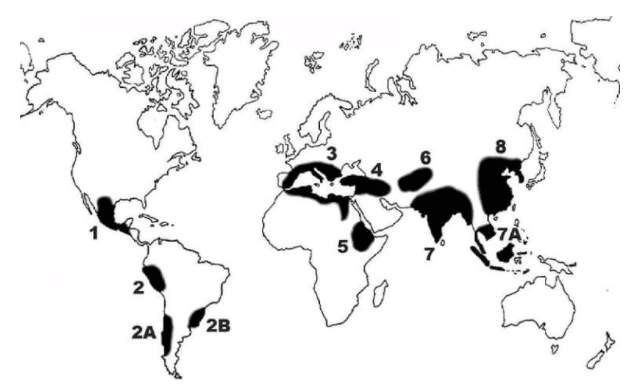
World centers of origin of cultivated plants
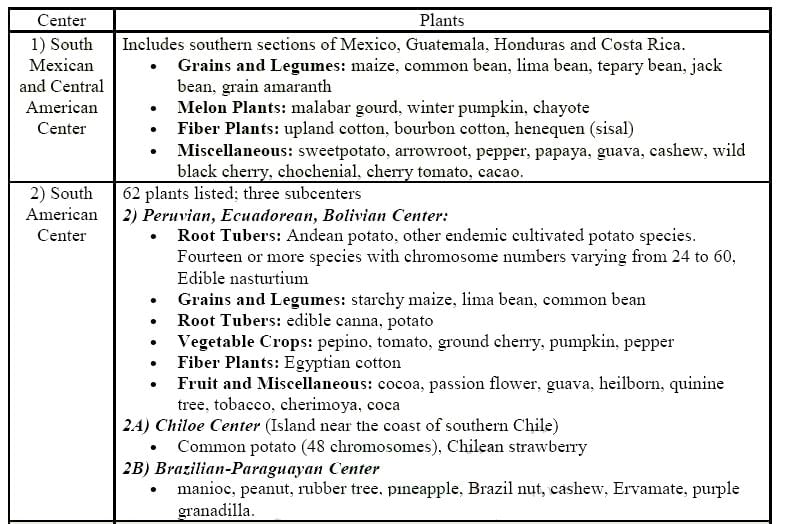
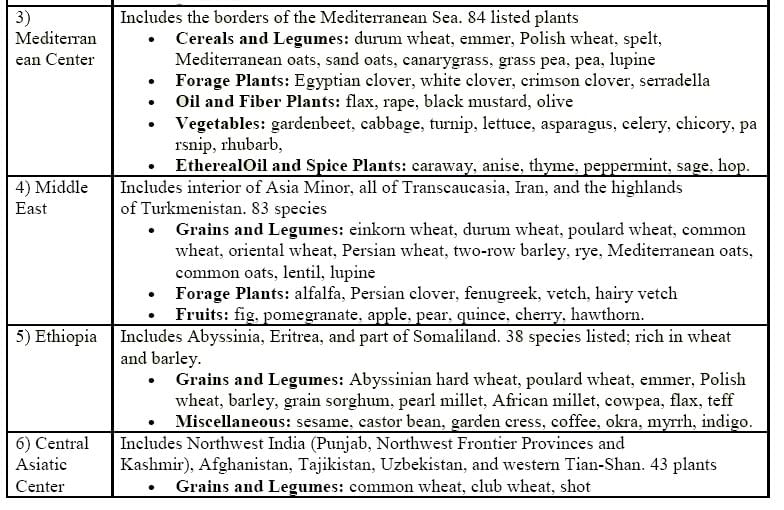
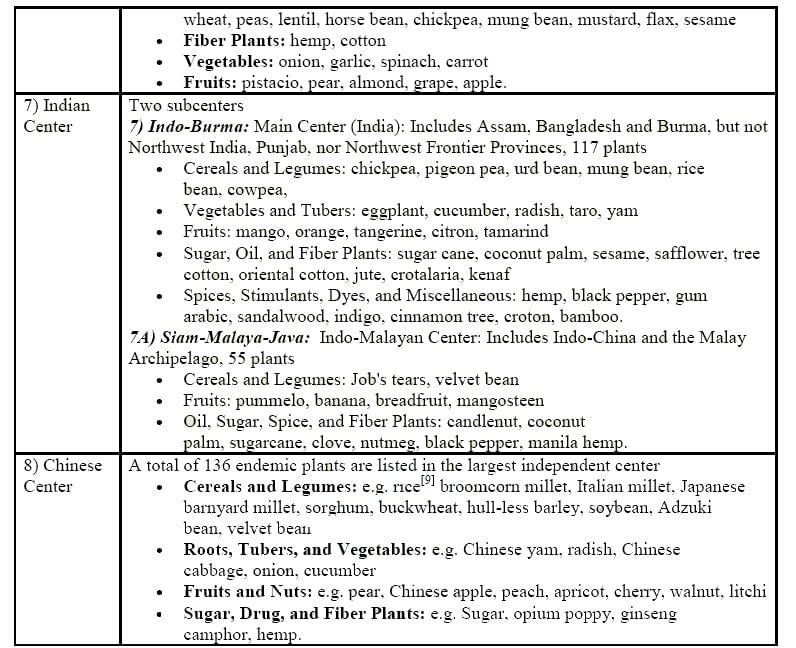
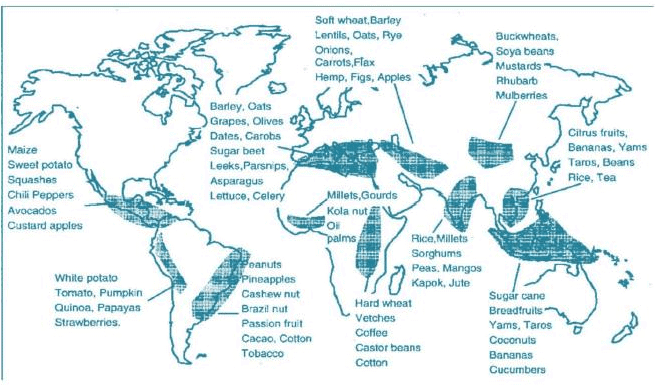
Importance of preserving Gene Pool
- The gene pool is a crucial aspect of biodiversity, as it represents the total number of genes present within a population. Populations with larger gene pools typically have more genetic diversity, which in turn provides them with a greater range of characteristics, resistance to diseases, and adaptability to harsh environments.
- A diverse gene pool is essential for the survival and health of a population. When there is a high level of genetic diversity, a population is better equipped to handle disease outbreaks or severe environmental changes, as the necessary protective genes are more likely to be present. Conversely, populations with smaller gene pools are more vulnerable to genetic diseases, deformities, and infertility, which can ultimately lead to their endangerment or extinction.
- Over the past century, there has been a significant loss of crop genetic diversity, with approximately 75% of it disappearing as farmers worldwide adopted genetically uniform, high-yielding varieties and abandoned local ones. This loss of diversity can have serious consequences, as it diminishes our ability to adapt and improve agriculture in the face of threats such as diseases or climate change, which can drastically alter growing conditions.
- There have been instances where the conservation of genetic material has proven to be vital for the development of more resilient crops. For example, a Turkish wheat variety that was collected and stored in a seed gene bank in 1948 was rediscovered in the 1980s, and was found to carry genes resistant to various types of disease-causing fungi. Plant breeders have since used these genes to develop wheat varieties with improved resistance to multiple diseases.
- In addition to its importance in agriculture, gene pool conservation is also essential for medical advancements. Many medicines are derived from plant and animal sources, such as neem oil and quinine from cinchona trees, which is used to prevent malaria.
In summary, preserving the gene pool is critical for maintaining the health and resilience of populations, as well as for promoting sustainable development in agriculture and medicine. By conserving genetic diversity, we can better equip ourselves to face the challenges posed by diseases, environmental changes, and other threats to the well-being of our planet and its inhabitants.
Conclusion
In conclusion, the gene pool is a vital aspect of biodiversity, representing the total genetic diversity within a population or species. Preserving gene pools is essential for maintaining the health and resilience of populations, sustainable agriculture, and medical advancements. By conserving genetic diversity, we can better adapt to challenges such as diseases, environmental changes, and other threats to our planet and its inhabitants. Vavilov Gene Pool Centers play a crucial role in understanding the evolution and distribution of cultivated plants worldwide, further emphasizing the importance of preserving these valuable genetic resources.Frequently Asked Questions (FAQs) of Major Gene Pool Centres
What is a gene, and how does it relate to the gene pool?
A gene is the fundamental unit of heredity, responsible for passing traits from parents to offspring. The gene pool refers to the total genetic diversity within a specific population or species at a given time. It is the collection of various genes present in an interbreeding population.
What are Gene Pool Centers, and why are they important?
Gene Pool Centers are geographic regions where significant crop plants and domestic animals first originated. These areas are characterized by an exceptional variety of wild relatives of cultivated plant species and useful tropical plants. Gene Pool Centers are important because they represent areas of high genetic diversity, which is crucial for the development of more resilient crops and the overall health of a population.
Who was Nikolai Vavilov, and what did he contribute to the understanding of gene pool centers?
Nikolai Vavilov was a Russian scientist who formulated hypotheses on the centers of origin for cultivated plants in the early 1920s. He identified regions known as Vavilov Gene Pool Centers, which he believed were the origin of main agricultural species and also areas of genetic diversification for various crops.
What are some examples of Vavilov centers of origin?
Some examples of Vavilov centers of origin include Mexico-Guatemala, Peru-Ecuador-Bolivia, Southern Chile, Paraguay-Southern Brazil, the Mediterranean region, the Middle East, Ethiopia, Central Asia, Indo-Burma, Siam-Malaya-Java, and China and Korea.
Why is preserving the gene pool important for the future of agriculture and medicine?
Preserving the gene pool is important for the future of agriculture because it allows for the development of more resilient crops that are better equipped to handle disease outbreaks or severe environmental changes. In medicine, gene pool conservation is essential because many medicines are derived from plant and animal sources, and preserving genetic diversity can help discover new treatments and cures for various ailments.
|
303 videos|636 docs|252 tests
|
FAQs on Major Gene Pool Centres - Geography Optional for UPSC
| 1. What are major gene pool centres? |  |
| 2. What are Vavilov gene pool centres? |  |
| 3. Why are Vavilov centers of origin important? |  |
| 4. What is the importance of preserving gene pool? |  |
| 5. What are some frequently asked questions about major gene pool centres? |  |















